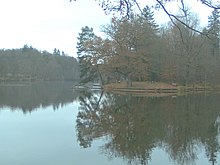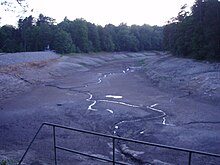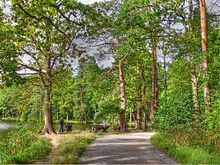Park lakes (Stuttgart)
The Stuttgart park lakes are within the boundaries of the Stuttgart districts Wildpark in the inner district of Stuttgart-West and Büsnau in the outer district of Stuttgart-Vaihingen . The park lakes in the Rotwildpark nature reserve near Stuttgart include the Bärensee , Neue See and Pfaffensee lakes, and the Katzenbachsee and Steinbachsee lakes in the Glemswald nature reserve . The Bärenschlössle on the Bärensee is known regionally and very popular for recreation in summer .
history
Before the introduction of an efficient long-distance water supply ( state water supply , Lake Constance water supply ) in the last century, Stuttgart was dependent on a few springs and the low water supply of the Nesenbach city stream . With the expansion of water pipes and spring taps for the then residential town, water was increasingly withdrawn from the Nesenbach, so that the mill operators settled in the town complained about water shortages as early as 1564.
The experts deployed for the investigation confirmed the water shortage and suggested creating an artificial lake in the Glemswald southwest of the city and thus catching a water source that had previously flowed unused into the Glems . The water should then be fed to the Nesenbach. On January 21, 1566, Duke Christoph decided to build the Pfaffensee at the knee of the uppermost Glems as well as a 2,810- foot- long tunnel to the Heidenklinge and thus over the Heslach waterfalls to the Nesenbachtal. However, since the tunnel was not built with the required gradient, it did not bring the desired improvement. After Christoph's death, his son Ludwig abandoned the project until the millers complained again about the water shortage. In 1575 the Christophstollen was completed and even the dry summer of 1578 did not bring the mills to a standstill.
After another water shortage, Duke Johann Friedrich created the Bärensee in 1618 about one kilometer to the west in the lower valley of the Bernhard Bach stream, which was connected to the Pfaffensee via an open canal along the slope. Remnants of this canal are partly still visible on the edge of the hiking trail by the lakes. At one point the canal had to overcome the valley cut of the flowing glems; for this purpose, an aqueduct made of solid stone was built, over which the hiking trail leads today.
It stayed with the two lakes for 200 years. It was only under King Friedrich in 1812 that the two lakes Steinbachsee and Katzenbachsee, about three kilometers away, to the west and southwest of Büsnau were created . Their water, too, was initially led to the Pfaffensee through open channels adapted to the terrain.
Wilhelm I commissioned the Württemberg hydraulic engineer Karl August Friedrich von Duttenhofer to improve the city's water pipes and fountain systems from 1825 to 1831. In addition to deepening the Pfaffensee and improving the gradient of the Christophstollen, Duttenhofer also initiated the construction of the New Lake at the inlet of the Bernhard Bach into the Glems. For this purpose, a dam was built in 1833, which dammed the outflowing Glems between Bären- and Pfaffensee into the fifth lake with the largest storage capacity to date.
From 1874, the lake water was fed directly to the newly built Hasenberg lake water works on the Hasenberg , without a detour via the Nesenbach , which processed it into drinking water and supplied it to Stuttgart. In 1933 this task was taken over by the Gallenklinge waterworks, to which the water was fed through the butcher's house tunnel built in 1930. At times, the New Lake also stored water from the Lake Constance water supply .
In April 1998 the water treatment from the lakes was stopped, since then the park lakes have been reserved for emergency water supply.
The lakes are owned by the state of Baden-Württemberg. They were previously leased by the municipal waterworks and the technical works of the city of Stuttgart (today EnBW). Due to a contractual obligation, EnBW Regional AG is now responsible for maintenance even after the shutdown and disuse .
In September 2008, the Neuer See was completely emptied in order to repair the leaky dam that closes the lake to the lower Glemstal. After the end of the work, water was returned to the lake from the beginning of September 2009, which was filled again at the end of 2009, although this was only expected after a year.
Sea data
The Katzenbach, Steinbach, Bernhardsbach and Glems tributaries feed the lakes with around 1,000,000 cubic meters of water a year. All the lakes together cover an area of approximately 27 hectares.
| Surname |
since |
Usable volume in m³ |
Level depth in m |
⌀ depth in m |
EZG in km² |
Area in ha |
district |
Coordinates |
|---|---|---|---|---|---|---|---|---|
| Pfaffensee | 1566 | 180,000 | 6.70 | 2.62 | 3.58 | 6.65 | wildlife Park | 48 ° 45 ′ 29 " N , 9 ° 6 ′ 27" E |
| Bear Lake | 1618 | 172,000 | 8.00 | 3.60 | 3.95 | 4.29 | wildlife Park | 48 ° 45 ′ 41 ″ N , 9 ° 5 ′ 21 ″ E |
| Katzenbachsee | 1812 | 80,000 | 4.10 | 2.60 | 4.06 | 2.70 | Büsnau | 48 ° 44 ′ 32 " N , 9 ° 4 ′ 26" E |
| Steinbachsee | 1812 | 40,000 | 4.70 | 1.90 | 3.70 | 1.46 | Büsnau | 48 ° 44 '50 " N , 9 ° 3' 47" E |
| New lake | 1833 | 340,000 | 7.40 | 5.75 | 0.30 | 6.51 | wildlife Park | 48 ° 45 ′ 25 " N , 9 ° 5 ′ 43" E |
![]() Map with all coordinates of the table: OSM
Map with all coordinates of the table: OSM
Recreation
The area around the lakes is very popular in the city of Stuttgart and is often overcrowded on weekends. Joggers, cyclists and hiking families then share the sometimes narrow paths. The numerous parking spaces along Magstadter Strasse and on Schattengrund (where the Katzenbach flows into the Glems ) often reach their capacity limits. The area is connected to the public transport of the SSB with the bus line 92 (stop Schattengrund and others) and for hikers at the university station with the S-Bahn.
Individual evidence
- ↑ Technical Works of the City of Stuttgart; Von Bronnen Wasserleittinen and Liechten ; Stuttgart 1957; Page 54.
- ↑ Homepage of the city of Stuttgart: Hasenberg lake water works
- ↑ Stuttgarter Zeitung ( page no longer available , search in web archives ) - A visit to the Botnang Gallenklinge waterworks.
- ↑ stuttgart.de - The largest bodies of water in Stuttgart: Max-Eyth-See, Neckar, park lakes.
- ↑ enbw.com - accessed on September 13, 2009.
- ↑ Stuttgarter Zeitung online ( Memento from September 13, 2012 in the web archive archive.today ) from September 1, 2009.
- ↑ Today's lake areas according to LUBW-SG10.
literature
- Adrienne Braun: In the middle and outside. Stuttgart's quiet corners. Südverlag, Konstanz 2014, ISBN 978-3-87800-054-9 , pages 47-53 (Bärenseen).
- Walter Meyer-König: Stuttgart and the water . Ed .: Technical Works of the City of Stuttgart AG. Stuttgart 1983.
Web links
- Park lakes in the red and wild boar park
-
Geoportal Baden-Württemberg ( information ), partial maps / layers of the State Institute for the Environment, Measurements and Nature Conservation Baden-Württemberg (LUBW)
- "LUBW-FG10": River 1: 10,000
- "LUBW-SG10": Standing water 1: 10,000
Coordinates: 48 ° 45 ′ 25 " N , 9 ° 5 ′ 43" E





